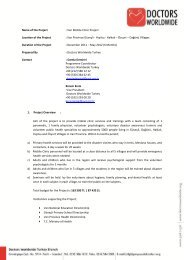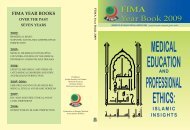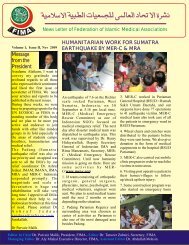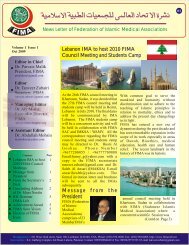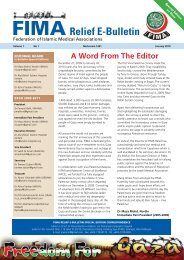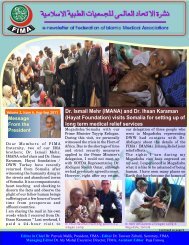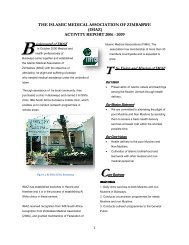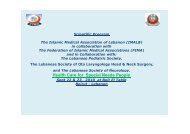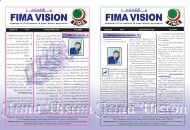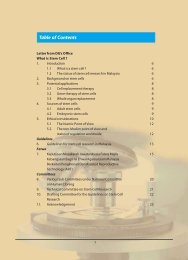FIMA Year Book 2010-2011 - Federation of Islamic Medical ...
FIMA Year Book 2010-2011 - Federation of Islamic Medical ...
FIMA Year Book 2010-2011 - Federation of Islamic Medical ...
You also want an ePaper? Increase the reach of your titles
YUMPU automatically turns print PDFs into web optimized ePapers that Google loves.
TOTAL DISASTER RISK<br />
Definition <strong>of</strong> Disaster:<br />
Disaster, according to WHO, is defined as a "a<br />
serious disruption <strong>of</strong> the functioning <strong>of</strong> a<br />
community or a society causing widespread<br />
human, material, economic or environmental<br />
losses, which exceed the ability <strong>of</strong> the affected<br />
community or society to cope using its own<br />
resources" 3 .<br />
Whereas the American College <strong>of</strong> Emergency<br />
Physicians states that a disaster has occurred<br />
"when the destructive effects <strong>of</strong> natural or manmade<br />
forces overwhelm the ability <strong>of</strong> a given area<br />
or community to meet the demand for health<br />
care" 4 .<br />
In simple terms, it is when there is “so much to do,<br />
by the so few, with so little resources” 4 .<br />
A disaster is a result <strong>of</strong> the combination <strong>of</strong><br />
hazards, conditions <strong>of</strong> vulnerability and<br />
insufficient capacity or measures to reduce the<br />
potential negative consequences <strong>of</strong> risk.<br />
This can be expressed in a simple equation:<br />
Disaster Risk = Hazard x Vulnerability /<br />
Capacity:<br />
Vulnerability is a set <strong>of</strong> conditions and processes<br />
resulting from physical, social, economical and<br />
environmental factors, which increase the<br />
susceptibility <strong>of</strong> a community to the impact <strong>of</strong><br />
hazards. Capacities are positive factors that<br />
increase the ability <strong>of</strong> people and the society they<br />
live in, to cope effectively with hazards, that<br />
increase their resilience, or that otherwise reduce<br />
their susceptibility.<br />
We may not be able to prevent hazards but if we<br />
can reduce vulnerability or increase the capacity<br />
<strong>of</strong> a given community, then we can reduce the<br />
probability <strong>of</strong> harmful consequences when a<br />
disaster strikes.<br />
As disasters happen more <strong>of</strong>ten and disaster risk<br />
increases in the world, the human society and its<br />
development are put to greater risk. Repeated<br />
disaster occurrence further worsens poverty,<br />
setbacks the economy, and impedes development.<br />
This is why reducing disaster risks are so<br />
important a concern and issue to sustainable<br />
human development.<br />
Total Disaster Risk Management (TDRM):<br />
It is an approach towards reducing disaster risks<br />
more significantly and responding to any disaster<br />
more effectively. The TDRM approach is a<br />
holistic viewpoint and course <strong>of</strong> action that allows<br />
us to appreciate and address the underlying causes<br />
<strong>of</strong> disaster risks. In recognizing disaster risk<br />
reduction and response as a prerequisite <strong>of</strong><br />
sustainable development, TDRM helps ensure that<br />
development efforts do not increase disaster risks,<br />
but instead, they preserve socio-economic<br />
investments and gains.<br />
As such, TDRM encourages us to have the<br />
following approach in understanding and dealing<br />
with disasters:<br />
1. We must deepen our understanding <strong>of</strong><br />
disaster risks.<br />
The triggering factors and conditions in the<br />
community that brought about this hazard are<br />
some <strong>of</strong> the answers that we seek. Economic,<br />
social and religious factors are important<br />
determinants and will have an impact during a<br />
disaster. Can we influence these factors then<br />
2. We must enhance our competence in<br />
dealing with disaster risks, with shared<br />
knowledge, experience and expertise.<br />
Identifying, analyzing, and assessing disaster risks<br />
are the activities that we need to prioritize,<br />
followed by communicating and educating the<br />
public at risk. Prevention, mitigation and<br />
preparedness activities will improve our capability<br />
to respond better for the incoming disaster.<br />
3. We must consolidate our capacities and<br />
actions through stronger cooperation.<br />
Knowing our own limitations in managing disaster<br />
risks and getting help from others in building each<br />
<strong>FIMA</strong> <strong>Year</strong><strong>Book</strong> <strong>2010</strong>-<strong>2011</strong> 42




